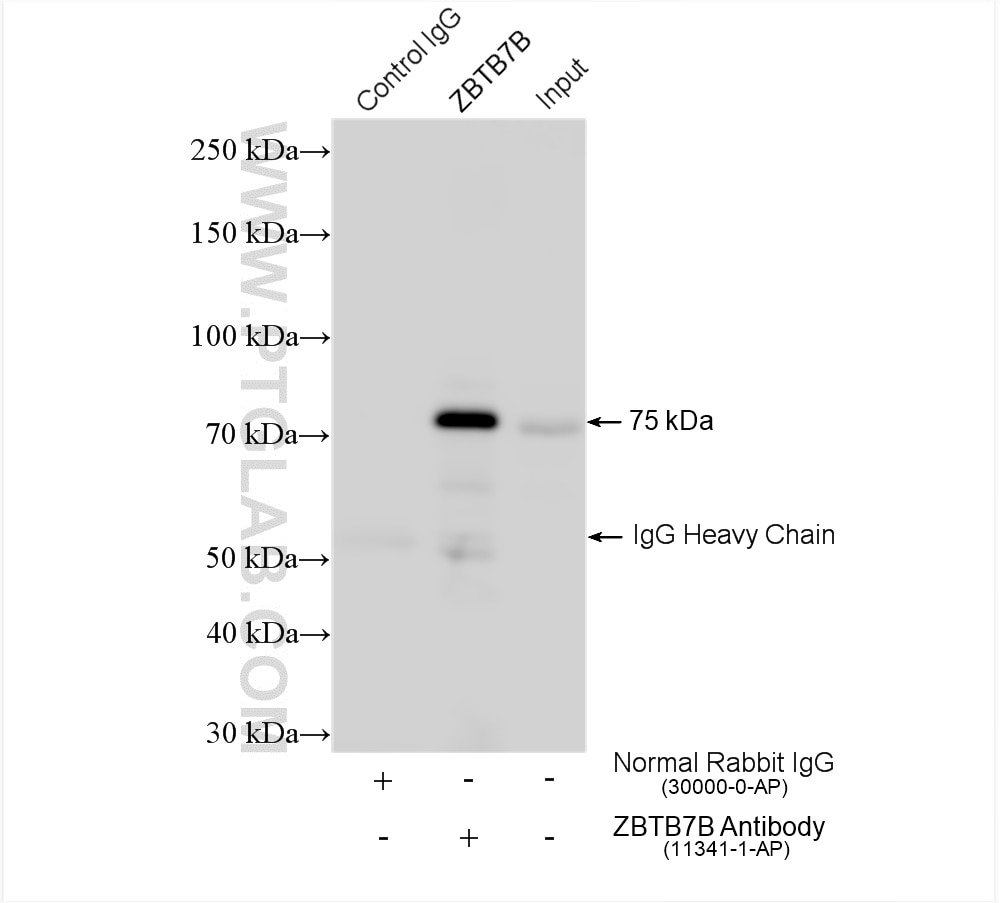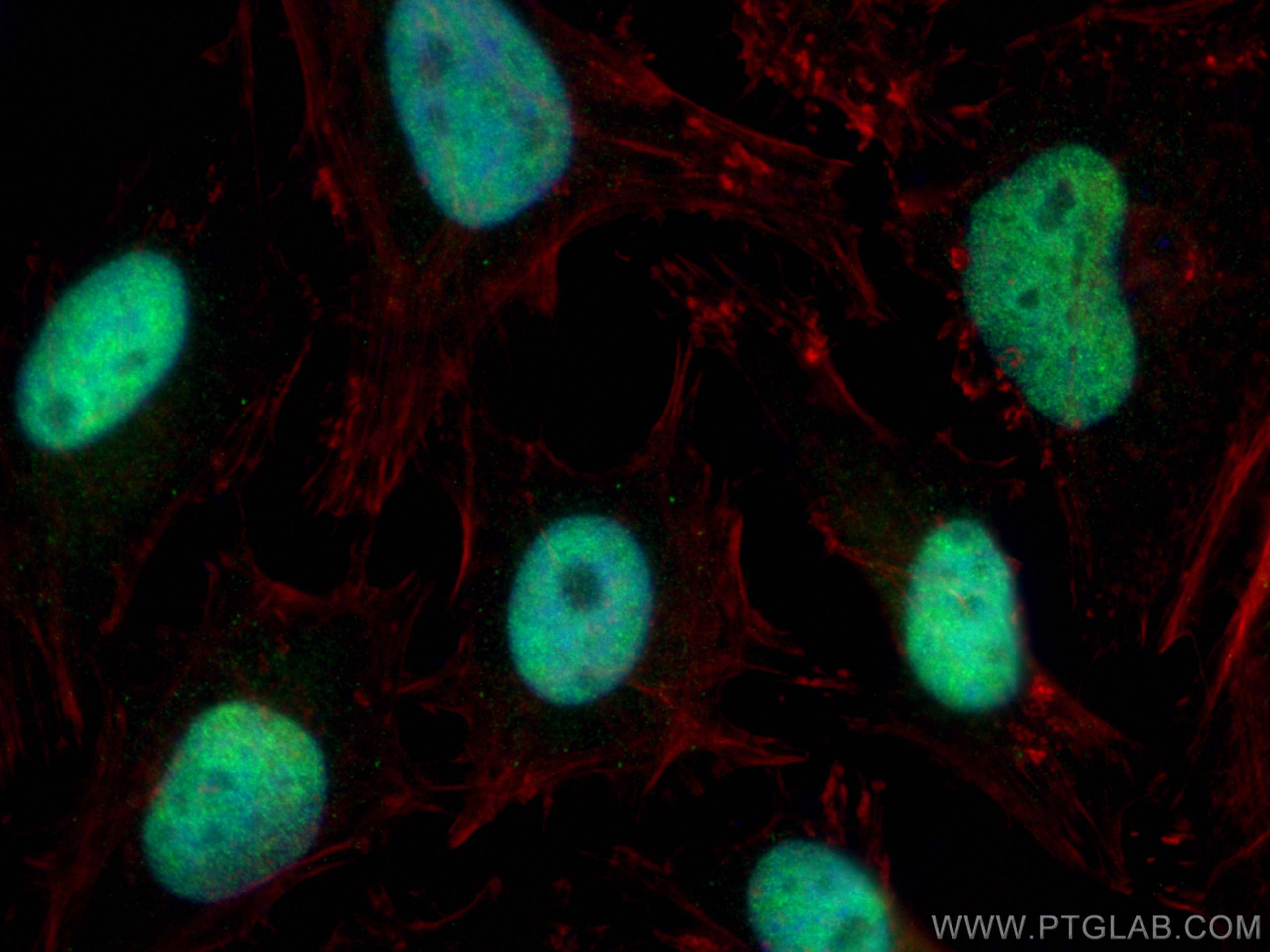Anticorps Polyclonal de lapin anti-ZBTB7B
ZBTB7B Polyclonal Antibody for WB, IF/ICC, IP, ELISA
Hôte / Isotype
Lapin / IgG
Réactivité testée
Humain, rat, souris et plus (2)
Applications
WB, IHC, IF/ICC, IP, ELISA
Conjugaison
Non conjugué
N° de cat : 11341-1-AP
Synonymes
Galerie de données de validation
Applications testées
| Résultats positifs en WB | cellules HeLa, cellules HepG2 |
| Résultats positifs en IP | cellules HeLa, |
| Résultats positifs en IF/ICC | cellules HeLa, |
Dilution recommandée
| Application | Dilution |
|---|---|
| Western Blot (WB) | WB : 1:1000-1:4000 |
| Immunoprécipitation (IP) | IP : 0.5-4.0 ug for 1.0-3.0 mg of total protein lysate |
| Immunofluorescence (IF)/ICC | IF/ICC : 1:800-1:3200 |
| It is recommended that this reagent should be titrated in each testing system to obtain optimal results. | |
| Sample-dependent, check data in validation data gallery | |
Applications publiées
| WB | See 4 publications below |
| IHC | See 2 publications below |
| IP | See 1 publications below |
Informations sur le produit
11341-1-AP cible ZBTB7B dans les applications de WB, IHC, IF/ICC, IP, ELISA et montre une réactivité avec des échantillons Humain, rat, souris
| Réactivité | Humain, rat, souris |
| Réactivité citée | bovin, Humain, souris, Hamster |
| Hôte / Isotype | Lapin / IgG |
| Clonalité | Polyclonal |
| Type | Anticorps |
| Immunogène | ZBTB7B Protéine recombinante Ag1888 |
| Nom complet | zinc finger and BTB domain containing 7B |
| Masse moléculaire calculée | 539 aa, 58 kDa |
| Poids moléculaire observé | 60-65 kDa |
| Numéro d’acquisition GenBank | BC012070 |
| Symbole du gène | ZBTB7B |
| Identification du gène (NCBI) | 51043 |
| Conjugaison | Non conjugué |
| Forme | Liquide |
| Méthode de purification | Purification par affinité contre l'antigène |
| Tampon de stockage | PBS with 0.02% sodium azide and 50% glycerol |
| Conditions de stockage | Stocker à -20°C. Stable pendant un an après l'expédition. L'aliquotage n'est pas nécessaire pour le stockage à -20oC Les 20ul contiennent 0,1% de BSA. |
Informations générales
ZBTB7B belongs to a large family of transcription factors, generally acting as repressors, characterized by a carboxy-terminal DNA binding domain made of multiple zinc fingers (four in Thpok) and an amino-terminal BTB-POZ domain that mediates homo- (and possibly hetero-) dimerization [PMID: 17084908]. Zbtb7b is up-regulated by MHC-II-restricted thymocytes during their CD4 differentiation and is a major determinant of CD4 lineage choice. Two properties of ZBTB7B deserve attention. First, although Thpok is expressed in a wide variety of cells, its expression in the thymus is highly lineage-specific : CD4 SP thymocytes (and all CD4 T cells) express Thpok, whereas DP and CD8 SP thymocytes do notSecond, both loss- and gain-of-function experiments indicate that Thpok affects lineage choice but not positive selection [PMID: 15729333, 10550051].
Protocole
| Product Specific Protocols | |
|---|---|
| WB protocol for ZBTB7B antibody 11341-1-AP | Download protocol |
| IF protocol for ZBTB7B antibody 11341-1-AP | Download protocol |
| IP protocol for ZBTB7B antibody 11341-1-AP | Download protocol |
| Standard Protocols | |
|---|---|
| Click here to view our Standard Protocols |
Publications
| Species | Application | Title |
|---|---|---|
Acta Biomater LAP2β transmits force to upregulate genes via chromatin domain stretching but not compression | ||
J Nanobiotechnology Edible exosome-like nanoparticles from portulaca oleracea L mitigate DSS-induced colitis via facilitating double-positive CD4+CD8+T cells expansion | ||
J Agric Food Chem Acylated Ghrelin Activates PI3K/mTOR Signaling Pathway by Promoting ThPOK Acetylation to Promote Milk Fat Synthesis in Bovine Mammary Epithelial Cells | ||
J Transl Med Epigenetic DNA methylation of Zbtb7b regulates the population of double-positive CD4+CD8+ T cells in ulcerative colitis. | ||
Cell Regen The critical role of BMP signaling in gastric epithelial cell differentiation revealed by organoids |




